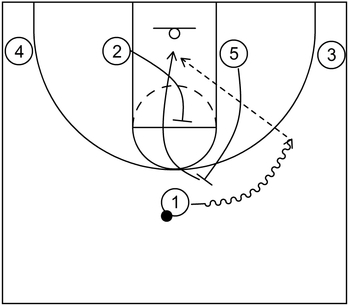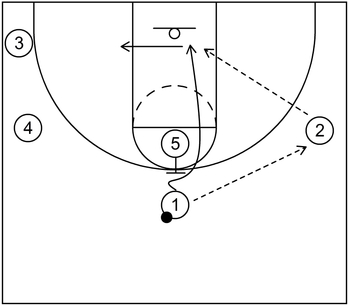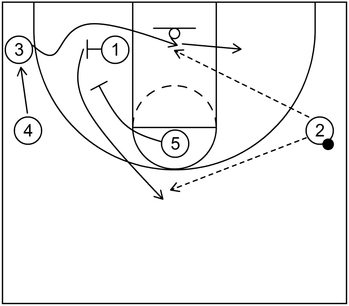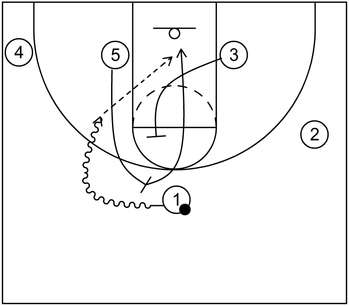What is Spain pick and roll in basketball
Spain pick and roll is a basketball offensive tactic that occurs when one particular player sets an on-ball screen and afterwards, that same player receives a back screen while rolling to the basket for a potential high percentage scoring opportunity.
Spain pick and roll is also comprised of screen the screener action because one particular offensive player cuts to an area of the court to set a screen (specifically an on-ball screen in this case) for a second offensive player and afterwards, the first offensive player receives a screen (specifically an off-ball back screen in this case) from a third offensive player.
Why is Spain pick and roll potentially effective
Spain pick and roll is potentially effective because it can neutralize the opposing team’s ball screen defensive tactics, most notably, the drop coverage tactic.
Essentially, when the offensive team executes a ball screen, or more specifically, pick and roll action, the defensive team would typically try to limit or prevent the effectiveness of that ball screen by implementing certain types of defensive tactics.
For example, let’s say that within a 5-on-5 basketball offense strategy, there is a separate two-man game consisting of two offensive players, denoted as player 1 and player 5, which would be the point guard and center, based on traditional basketball positions.
Let’s also say that there are two defenders guarding each of those offensive players, specifically with man to man defense, denoted as X1 and X5, which for this instance, are the defensive point guard and defensive center positions, respectively.
Also, for simplistic purposes, let’s say that the other three offensive and defensive players are on the court but they are not currently involved in this initial two-man action.
From there, let’s say that player 1 has possession of the basketball at the top and then player 1 calls for an on-ball screen from player 5 while being guarded by X1.
When that occurs, X5, who is the defender that guards player 5, has a few options to mitigate the effectiveness of the on-ball screen.
X5 could perform a defensive hedge to slow down possible dribble penetration of player 1 before recovering to player 5, who rolled to the basket.
In this scenario, if X5 performs a defensive hedge tactic, especially a hard hedge, then one of the weak side defenders that is generally not involved in the two-man action could tag the roll man (i.e. cover player 5) until X5 is able to recover back to player 5.
X5 could also execute the drop coverage tactic by staying slightly above or slightly below the free throw line area while the on-ball screening action occurs.
The drop coverage could be employed if X5 is too slow to recover quickly enough as utilized with the defensive hedge.
Also, if X5 knows or at least feels very confident that player 5 is most certainly going to roll to the basket and player 1 is not going to take a jump shot near the perimeter areas of the court, then X5 could implement the drop coverage in that case as well.
The drop coverage is useful because when player 5 rolls to the basket, X5 is already near the pathway of that rolling action.
Therefore, even if player 5 receives the ball from player 1, it would basically become a 1-on-1 occurrence between X5 and player 5.
Additionally, X5 could execute a defensive switch with X1 to cause the pick and roll action to become ineffective.
The drawback to the defensive switch, in this case, is that it essentially creates defensive mismatches between X1 and X5.
That is to say, X5 would most likely not be fast enough to contain the speed and quickness of player 1 and X1 would probably not be tall enough or strong enough to stop player 5 from scoring near the basket after the roll action.
In either situation, the defensive team, particularly X5, the screener’s defender will try to restrict the use of the roll action.
Spain pick and roll could be utilized as a counter to the defensive tactics mentioned above by adding a third offensive player, who would target the screener’s defender (e.g. X5) with a back screen to free up the roll man (e.g. player 5).
In other words, if X5 executes a defensive hedge, then the back screen attempts to slow down or completely stop the recovery that occurs after the hedge action.
If X5 performs drop coverage, then the back screen gives the roller, player 5, an opportunity to continue the cut deep towards the basket as opposed to being contained by X5 prior to the completion of the roll.
Moreover, if X5 implements defensive switching, then X1 (or perhaps, another defender in this event of a three-man switch) would be the target of the back screen, which still gives player 5 an opportunity to roll deep towards the basket.
It should also be noted that Spain pick and roll action could possibly be more potent than it already is if a perimeter player such as a point guard, shooting guard, or small forward executes the back screen while a post player such as a power forward or center rolls to the basket.
That is to say, when a post player uses a screen that was set by a perimeter player, it causes switching to become an even greater challenge for the defensive team.
Affiliate Disclosure: I may earn a commission on qualifying purchases made through the links below.
What are examples of basketball plays that feature Spain pick and roll
Example 1

This is a very basic example of a quick hitting basketball play that features Spain pick and roll action, initiated from a 1-4 low alignment.
To start, 1 dribbles toward the right side wing via an on-ball screen set by 5. Following that, 5 rolls to the basket by way of a back screen set by 2. Afterwards, 5 could receive the ball from 1 and score at the rim via a layup or dunk.
Example 2 – Part 1

This is an example of a basketball play that demonstrates Spain pick and roll action, which seeks to produce several scoring options.
It is also based on insights derived from Great Pick and Roll Plays by Lason Perkins.
To start, 2 receives the ball from 1 near the right side wing and following that, 1 cuts to the basket via the back screen set by 5 near the high post area.
From there, 1 could receive the ball again from 2 and score by way of a layup if that is open. If 1 cannot receive the ball from 2, then 1 could continue to cut towards the left side low post block.
Example 2 – Part 2

Next, 3 could cut to the basket by way of a flex screen set by 1, receive the ball from 2, and score at the rim with a layup or dunk if that is open.
Also, immediately after the flex screen, 1 could cut back to the top via a down screen set by 5, which also completes screen the screener action.
Moreover, as a secondary scoring option, 1 could receive the ball from 2 and take the three-point jump shot if open.
Furthermore, if 1 receives the ball but an open jump shot is not available, then 3 could continue to cut through to the right side low post block while 4 fills the vacant left side corner area.
Example 2 – Part 3

After that, 1 could dribble towards the basket via the on-ball screen set by 5. Additionally, following the dribble penetration, 5 could roll to the basket and receive a back screen from 3.
Next, 5 could receive the ball from 1 and score around the rim with a layup, dunk, or low post move.